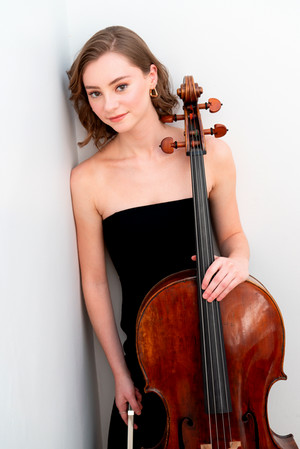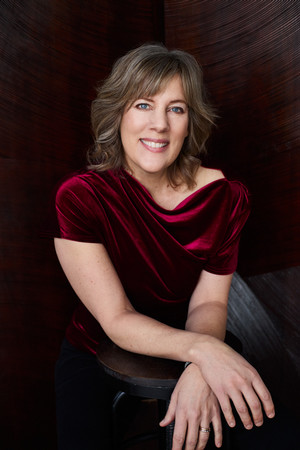
Mount Royal Conservatory presents Luka Coetzee with special guest Susanne Ruberg-Gordon
Digital concert program
Luka Coetzee, cello
with Susanne Ruberg-Gordon, piano
PROGRAM
Nadia Boulanger (1887-1979)
Three Pieces (1914)
I. Modéré
II. Sans vitesse et à l’aise
III. Vite et nerveusement rythmé
César Franck (1822-1890)
Violin Sonata in A Major (1886)
I. Allegretto ben moderato
II. Allegro
III. Recitativo-Fantasia
IV. Allegretto poco mosso
---INTERMISSION---
Vincent Ho (b. 1975)
Dragon Dance (world premiere)
Krzysztof Penderecki (1933-2020)
Suite for Solo Cello (1994-2013)
I. Preludio
II. Serenade
VIII. Notturno
Claude Debussy (1862-1918)
Sonata, L. 135 (1915)
I. Prologue
II. Sérénade
III. Finale
Astor Piazzolla (1921-1992)
Le Grand Tango (1982)
*PROGRAM SUBJECT TO CHANGE*
Sheldon Artists LLC
www.sheldonartists.com
Program Notes
Nadia Boulanger (1887-1979)
Three Pieces for Cello and Piano (1914)
A teacher and pedagogue of world renown, Nadia Boulanger’s legacy permeates Western art music, most notably through the remarkable influence she had teaching at the French Music School for Americans. She entered the Paris Conservatoire at nine years old, where she studied composition with Gabriel Fauré, and subsequently developed a career as a composer, conductor, early music pioneer, trusted advisor to Stravinsky and Poulenc, and as a teacher, inspiring an impressive list of many of the most influential American composers of the first half of the 20th century.
Most of Nadia Boulanger’s music was composed between 1904 and 1918, and her Three Pieces, published in 1915, was originally composed for organ in 1911 as part of an anthology. This explains the oddity of the titles, typically represented by only number and key. The titles in the original manuscript were different, Improvisation, Prélude, and the third referred to in a program for the premiere performance as “Danse Espagnole,” which Nadia performed alongside cellist Fernand Pollain at a gala evening organized by the Boulanger sisters at the Théâtre Léon Poirier in Paris on 18 November 1913.
César Franck (1822-1890)
Violin Sonata in A Major (1886)
Transcribed for cello by Jules Delsart
Composed during the final decade of his life, César Franck’s Sonata in A Major was a wedding present for fellow Liège-born artist, violinist Eugene Ysaÿe, performed first by Ysaÿe at his own wedding on 26 September 1886. Months later, Ysaÿe and Franck gave the first public performance of the sonata during a festival of Franck’s music in Brussels. At the French premiere one year later at the Société Nationale in Paris, the audience reception was so positive that the finale was repeated.
The Sonata in A Major has since emerged as one of the most revered 19th-century compositions for violin and piano. Its enduring popularity has inspired transcriptions for several other instruments— flute, double-bass, saxophone, organ (with mixed choir), and, most frequently, the cello. The first version for cello was arranged by a prominent French cellist and contemporary of Franck, Jules Delsart (1844–1900), and is the only alternative version produced in collaboration with the composer.
Vincent Ho (b. 1975)
Dragon Dance (2024)
Vincent Ho writes: Dragon Dance was written in celebration of the Year of the Dragon and inspired by my daughter’s (Claudia) Chinese Zodiac animal. Ever since she was a child, Claudia loved music that had engaging rhythms, Eastern harmonies, fast tempi, and folkloric elements. With these in mind, I conjured a musical narrative that would express many of these concepts and ideas. As well, many of these ideas draws on the performance practices of Chinese traditional instruments but adapted for cello and piano.
The music begins with the emergence of the dragon coming out of the sea. As it settles onto land, it excitedly chases the animals it comes across as a playful game. Once catching up to the animals, they all engage in a rustic dance as a celebration. This eventually leaves the dragon exhausted, gradually making it fall into a sleepy slumber on the beach.
Claude Debussy (1862-1918)
Sonata, L. 135 (1915)
In the final years of Claude Debussy’s life, he set out to write a collection of six sonatas for various musical forces, the sixth to be a combination of all the instruments in a chamber setting. He finished only three, and the cello sonata is perhaps the most visceral, intensified through Debussy’s extensive use of fragmented themes, laced with adventurous harmonic language, and yet, a nostalgic classicism. In a letter to his publisher, Debussy wrote “I like the Cello Sonata’s proportions and form, which are almost classical in the best sense of the word.”
The Cello Sonata is dedicated to French singer Emma Bardac, notoriously known for her role in both the lives of Debussy and Gabriel Fauré. The sonata was premiered in London’s Aeolian Hall in 1916, with the French premiere a year later by cellist Joseph Salmon, alongside Debussy himself at the piano.
Astor Piazzolla (1921-1992)
Le Grand Tango (1982)
Born in Argentina to Italian parents, Astor Panteleón Piazzolla, the great tango composer and virtuoso bandoneón player, was also a New Yorker. From age five through fifteen he lived with his family in Greenwich Village and Lower Manhattan, and the musical hotbed of New York City in the 1920s was as influential on Piazzolla as it was the rest of the world. This period saw young Astor paired with his first bandoneón—a German instrument developed in
Argentina—which he used to explore the plethora of jazz and commercial music surrounding him, and together with his teacher—a student of Rachmaninoff—to play the music of J.S. Bach.
Piazzolla returned to Argentina in his late teens, where he spent five years studying composition with Alberto Ginastera, and a subsequent five years under the instruction of concert pianist Raúl Spivak. At age thirty-two, Piazzolla’s three movement symphony won the Fabian Sevitzky Award, resulting in a grant for extensive compositional studies in Paris under none other than…Nadia Boulanger, and her influence on him was great.
Prolific Argentine pianist Martha Argerich was responsible for Le Grand Tango, by way of suggesting to Piazzolla in 1982 that he compose it for the music director of the National Symphony Orchestra in Washington, DC, cellist Mstislav Rostropovich, who premiered, recorded, and championed the work in his late career. Rostropovich’s grand student performs it for you today.
Artist bios

Luka Coetzee, cello
“Tonally, technically, and musically superb,” Canadian cellist Luka Coetzee (b. 2004) “plays sublimely, with an interpretative grasp [and] phenomenal musicianship [that] should on no account be missed” (Fanfare Magazine). Since her professional debut at age 11, Luka has appeared as soloist with orchestras worldwide including the Helsinki Philharmonic, Lahti Symphony, Cape Town Philharmonic, National Philharmonic, Stuttgart Chamber, Tapiola Sinfonietta, Hradec Kralove Philharmonic, National Orchestre de Cannes, and more.
Luka received numerous awards including First Prize in 2023 at the eminent 7th International Paulo Cello Competition. In November 2022, she was recognized as the First Prize Winner at the Pablo Casals International Award, and in September, she received the Frans Helmerson Promotional Award at the Kronberg Academy, as well as First Prize in the 2022 Johansen International Competition in Washington, DC, garnering further attention for her exciting introduction as an international soloist.
As a member of the Echo Klassik-nominated LGT Young Soloists, Luka performed in concert halls around the world including the Elbphilharmonie Hamburg, Berlin Philharmonie, Tonhalle Zürich, Victoria Hall Singapore, Rheingau Musik Festival, and Woordfees Festival in Stellenbosch, South Africa. With LGTYS, Luka’s critically acclaimed Naxos recording of the Beethoven A Major Cello Sonata, arranged for cello and strings, was No. 1 on the Apple Music Classical Video Charts in more than 40 countries, including the US, UK, Germany, France, Italy, Spain and Japan.
Luka draws inspiration from her work with distinguished artists worldwide, including Johannes Moser, Frans Helmerson, David Geringas, Nicolas Altstaedt, Jens Peter Maintz, Laurence Lesser, and Hans Jorgen Jensen, as well as the Calidore String Quartet, the Kronos Quartet, and the Schumann Quartet. In November 2021, Luka attended the Rutesheim Cello Akademie where she worked with Danjulo Ishizaka and Claudio Bohorquez, and more recently the Prussia Cove Masterclasses under the guidance of Steven Isserlis. An avid
chamber musician, Luka participated in the Music@Menlo Chamber Music Festival Young Performer’s Program in 2019 and 2018.
Luka frequently performs at schools, hospitals, senior homes, and community events. She was the Calgary Regional Director of the Back to Bach Project, “a global initiative to inspire music and arts education to young children.” At the age of one, Luka had her first cello lesson with Christine Bootland. She graduated from the Advanced Performance Program at the MRU Conservatory where she collaborated with and was mentored by Susanne Ruberg-
Gordon. Other previous mentors include John Kadz, Johanne Perron, Horacio Contreras, and currently, by Wolfgang Emanuel Schmidt at the Kronberg Academy. Luka also started playing piano at the age of three and finished the Royal Conservatory of Music ARCT piano exam with First Class Honours under the instruction of Derek Chiu.
Luka Coetzee is represented worldwide by Sheldon Artists. She is an Endorsing Artist for Thomastik-Infeld strings (Vienna).
lukacoetzee.com

Susanne Ruberg-Gordon, piano
Quoted by the Chronicle Herald as “A superb musician”, Swedish-born pianist Susanne Ruberg-Gordon is a highly regarded and sought after chamber-musician and collaborative pianist. She is recognized for her artistry, nuance and interpretation, and has performed in Canada, the US, China and UAE with artists such as Dame Evelyn Glennie, Andras Diaz, Ron Leonard, Ian Swensen, James Campbell, Timothy Chooi, Nikki Chooi, Desmond Hoebig, John Kimura Parker, Josh Jones, Arnold Choi, Ben Reimer, Sydney Lee and Xavier Foley.
Susanne is the pianist and core member of the Juno nominated Land’s End Ensemble, a piano-trio that is dedicated to excellence in performance and recording of Canadian and International new music, and to enriching collaborations with eminent composers and artists.
The ensemble has premiered over 125 new chamber works and is featured on 8 commercial recordings. The newest album, released in July of 2024 on Naxos, features John Corigliano’s Mr. Tambourine Man (soprano and sextet version) and Gryphon Realms (piano trio) by Vincent Ho.
“This was only one work of many in which Ms. Ruberg-Gordon achieved the finest balance acting as both the core sound and the glue of Land’s End Ensemble, absolutely ideal playing all night” - Stephan Bonfield
“Her pianism everything the composer could wish for” - Calgary Herald
As a passionate educator and adjudicator, Susanne is a faculty member and facilitator at the Mount Royal University Conservatory Academy and APP Programs. She is also on faculty at the Valhalla Summer School of Music in New Denver, BC. Since 2001, she has been a Collaborative Artist for the prestigious and acclaimed Morningside Music Bridge program in Canada, US, China and Poland.

